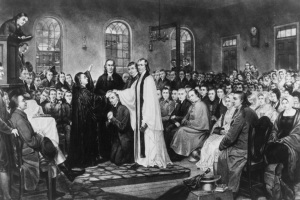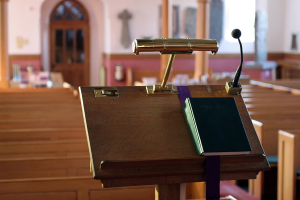Scientists Say Shroud of Turin Shows Jesus Was Crucified in 'Very Painful' Position, With Arms Over Head
A new study conducted by Liverpool scientists suggests the Shroud of Turin proves Jesus was crucified with his hands over his head in a "Y" shape, rather than to the sides in a "T" shape, as traditionally depicted in Christian art. The scientist leading this recent study says this new crucifixion would be "very painful" and likely cause asphyxiation for the victim.
Scientists at the Liverpool John Moores University in the U.K. announced their findings at the American Academy of Forensic Sciences earlier this year. They argue that the Shroud of Turin, believed by some to be the burial cloth of Jesus, shows an image of a man with blood stains streaking down his arms. Matteo Borrini, who led the shroud study at the John Moores University, argues that these stains could only have been obtained if the victim's arms were hung over his head in a "Y" shape, instead of the "T" shape that is so prevalent in Christian art.
The scientists reached their new conclusion after having scientist Luigi Garlaschelli of the University of Pavia, Italy, act out different crucifixion poses with donated blood dripping down his arms via a cannula.
As Borrini told the New Scientist, this new crucifixion position would have been much more painful than the "T" shaped crucifixion, as being hung with one's arms above their head makes it very difficult to breathe. The scientists further suggested that one hung in a "Y" shape would likely die from asphyxiation.
"This would have been a very painful position and one which would have created difficulty breathing," Borrini said.
The validity of the Shroud of Turin has long been disputed, with some arguing that the linen is in fact Jesus' burial cloth, and others arguing that the piece of fabric is a master forgery from the Medieval Times. As Borrini indicates, medieval torture often included hanging a victim with their arms above their head using rope. However, he did add that if the shroud is a forgery, it is expertly done since the blood stains line up as accurately as if they were produced from an actual crucifixion.
Scientists have created several theories regarding the Shroud of Turin over the years. In another recent study conducted by the Politecnico di Torino University in Torino, Italy, scientists suggested that the male image on the linen was created by neutron emissions from an earthquake that took place in 33 a.d. Jerusalem. These scientists reached their conclusion by crushing brittle rock segments in a pressure machine to stimulate an earthquake, finding that when nitrogen atoms and linen fibers met, they created a facial image.




























